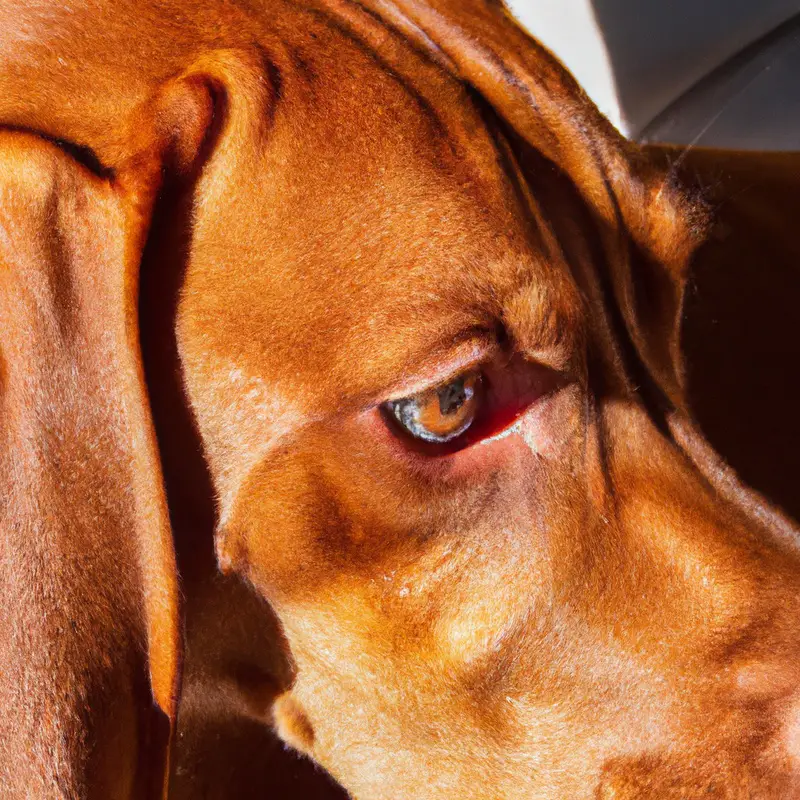What Are Some Common Vizsla Tail Issues And How To Care For Them?
Key Takeaways:
- Vizslas are prone to tail injuries, such as “happy tail syndrome,” which can be managed with careful treatment.
- Regular grooming and keeping the tail area clean and dry can help prevent infections and irritations in Vizslas.
- Proper exercise and mental stimulation are crucial to prevent boredom-related tail-chasing behaviors in Vizslas.
- Consult a veterinarian if you notice any signs of discomfort or unusual behavior related to your Vizsla’s tail.
Are you a proud Vizsla owner, mesmerized by their sleek and elegant tails?
Well, just like any other part of their body, Vizsla tails can sometimes face issues too.
From pesky hematomas to troublesome allergies, these tail issues can cause discomfort to your furry companion.
But fret not! In this article, I’m here to educate you about the common tail problems that Vizslas can experience and provide you with practical tips on how to care for them.
Whether it’s consulting a veterinarian or learning how to treat specific conditions like fractures, inflammation, or infections, I’ve got you covered.
So, grab a cup of coffee, sit back, and let’s delve into the world of Vizsla tail issues together!
| Common Tail Issues | Care Tips |
|---|---|
| Tail injuries | Keep the tail protected and clean, avoid strenuous physical activity, consult a veterinarian for treatment |
| Tail infections | Ensure proper hygiene, regularly clean the tail, use veterinarian-prescribed medication if necessary |
| Tail docking complications | Follow the appropriate procedure during tail docking, seek professional assistance if complications arise |
| Broken tail | Restrict movement, apply ice packs to reduce swelling, seek veterinary attention immediately |
| Happy tail syndrome | Prevent additional injuries, protect the tail with bandages or a protective cover, consult a veterinarian for treatment options |
| Injury from wagging | Monitor wagging behavior, avoid tight spaces or sharp objects, provide a safe and spacious environment |
Common Vizsla tail issues
1. Hematoma
Hematoma is a common tail issue experienced by Vizslas.
It occurs when blood vessels in the tail rupture, causing a buildup of blood under the skin.
This can be caused by trauma, including excessive tail wagging or docked tail procedures.
If your Vizsla develops a hematoma, it’s important to seek veterinary care.
Treatment options may include draining the hematoma, administering medication, or, in severe cases, surgery.
Preventative measures, such as avoiding activities that could lead to tail trauma, can help minimize the risk of hematoma.

2. Fractured tail
Fractured tail is a common issue in Vizslas. It can happen due to accidents or excessive wagging.
If you notice any signs of a fractured tail, such as swelling or pain, it is important to seek veterinary care.
The vet may recommend rest, pain medication, and possibly even a splint or bandage to support the tail. It’s crucial to follow the veterinarian’s instructions and avoid any activities that could worsen the injury.
With proper care and attention, Vizslas can recover from a fractured tail.
3. Inflammation or infection
Inflammation or infection can be common issues that affect a Vizsla’s tail. You may notice redness, swelling, or discharge around the tail area.
To care for these issues, ensure proper hygiene by regularly cleaning the tail and keeping it dry.
Consult a vet for appropriate treatment, which may include antibiotics or anti-inflammatory medication. Be mindful of your Vizsla’s behavior and watch for any signs of discomfort or worsening symptoms.
4. Allergies or dermatitis
Allergies or dermatitis can be common issues for Vizslas.
They can develop allergies to food, environmental factors, or even certain chemicals.
This can lead to symptoms like itchiness, redness, and hair loss.
To care for these issues, it is important to identify and address the underlying cause of the allergy.
This may involve a diet change, avoiding certain substances, or providing medication as recommended by a veterinarian.
Regular grooming and keeping the environment clean can also help manage allergies and dermatitis for your Vizsla.

How to care for Vizsla tail issues
Consulting a veterinarian
Consulting a veterinarian is the best course of action when dealing with any tail issues in your Vizsla.
A veterinarian has the expertise and knowledge to accurately diagnose and treat any problems that may arise.
They can provide guidance on proper care, recommend treatments, and offer advice on preventing future issues.
Remember, it’s important to seek professional advice to ensure the health and well-being of your Vizsla.

Treating hematoma in Vizslas
Treating a hematoma in Vizslas involves seeking veterinary care as soon as possible. The vet may drain the fluid or recommend surgery depending on the severity.
After treatment, follow their instructions for wound care and medication.
It’s important to prevent your Vizsla from scratching or shaking their head excessively to avoid re-injury. Regular check-ups with the vet can help monitor the healing process and ensure your Vizsla’s tail recovers fully.
Managing a fractured tail in Vizslas
Managing a fractured tail in Vizslas can be challenging but there are a few steps you can take to help your furry friend.
First, keep the tail clean and dry to prevent infection.
You can use a mild antiseptic solution and gentle cleaning.
Next, restrict your Vizsla’s physical activity to avoid further injury.
Pain medication prescribed by the vet can also be helpful.
Finally, provide a comfortable and quiet environment for your pup to rest and heal.
Always consult your veterinarian for proper diagnosis and treatment.
Treating inflammation or infection in Vizslas
Treating inflammation or infection in Vizslas is an important aspect of their overall health and well-being.
If you notice any signs of inflammation or infection in your Vizsla’s tail, such as redness, swelling, discharge, or discomfort, it’s crucial to take action.
Here are some tips to help you care for your Vizsla’s tail:
- Clean the affected area gently with a mild, veterinarian-approved antiseptic solution.
- Apply a veterinarian-recommended topical antibiotic ointment to help prevent infection and promote healing.
- Use a clean, soft cloth to gently dry the area after cleaning, being careful not to irritate the skin.
- Keep an eye on your Vizsla’s tail for any signs of worsening or persistent inflammation or infection.
- If the condition doesn’t improve or if your Vizsla shows any signs of discomfort, consult with a veterinarian for further evaluation and treatment options.
Managing allergies or dermatitis in Vizslas
Allergies and dermatitis can be a common issue for Vizslas. To manage these conditions, it’s important to identify and avoid trigger substances, such as certain foods or environmental allergens.
Regularly grooming and bathing your Vizsla can help reduce itchiness and inflammation.
Additionally, your vet may recommend medications or supplements to alleviate symptoms. Keeping your Vizsla’s skin clean and moisturized can also help prevent dermatitis.
If you notice any signs of allergies or dermatitis, consult with your vet for proper diagnosis and treatment.
Frequently Asked Questions (FAQs) about Vizsla tail issues
What are the signs of a fractured tail in a Vizsla?
If you suspect your Vizsla may have a fractured tail, there are a few signs to look out for. These can include swelling or bruising around the tail area, sensitivity or pain when the tail is touched or moved, and a change in the shape or position of the tail.
Your Vizsla may also show signs of discomfort or difficulty wagging their tail.
If you notice any of these symptoms, it’s important to consult your veterinarian for a proper diagnosis and treatment plan.
Can Vizsla tail issues be prevented?
Yes, Vizsla tail issues can be prevented through proper care and attention. Here are some tips:
- Regular grooming: Keep your Vizsla’s tail clean and free from tangles or mats by brushing it regularly. This helps prevent any skin irritations or infections.
- Exercise and mental stimulation: Provide your Vizsla with plenty of physical exercise and mental stimulation to prevent them from excessive tail-chasing or self-injury.
- Tail docking: If you decide to have your Vizsla’s tail docked, it is important to choose a reputable and experienced veterinarian to perform the procedure.
- Protect the tail: Be mindful of your Vizsla’s surroundings and avoid situations where their tail could get caught or injured, such as playing in rough or sharp areas.
- Regular veterinary check-ups: Schedule routine visits to the vet to ensure that any potential tail issues or health concerns are identified and addressed early on.
Remember, prevention is key when it comes to keeping your Vizsla’s tail healthy and happy. By taking these steps, you can significantly reduce the risk of tail issues for your furry friend.
Are Vizslas more prone to tail issues compared to other breeds?
Vizslas are not inherently more prone to tail issues compared to other breeds.
However, they do have a unique characteristic called a “whip tail” which makes their tail more susceptible to injuries.
This long, thin tail can easily become injured from wagging too vigorously, hitting objects, or getting caught in doors.
It’s important to be cautious and protect their tail from potential harm.
Regular vet check-ups and proper care can help prevent and address any tail issues that may arise.
Can I treat Vizsla tail issues at home?
Yes, you can treat some Vizsla tail issues at home. However, it’s important to note that if your dog is in severe pain or the issue persists, it’s best to consult a veterinarian.
Here are some common Vizsla tail issues and home care tips:
- Tail injuries: Clean the area gently with a mild antiseptic solution, apply a clean bandage, and monitor for any signs of infection or worsening. Seek veterinary care if the injury is deep or doesn’t improve.
- Tail infections: Keep the tail area clean and dry. Cleanse the infected area with a vet-recommended antiseptic solution, and apply a prescribed topical ointment or medication.
- Hot spots: Trim the hair around the affected area to expose it to air. Clean the spot with a vet-approved antiseptic solution and apply a prescribed topical ointment. Prevent your Vizsla from licking or scratching the hot spot.
- Tail docking complications: If your Vizsla experiences any complications after tail docking, such as excessive bleeding or infection, contact a veterinarian immediately. They will provide appropriate treatment and care.
Always closely monitor the condition and behavior of your Vizsla. If you have any concerns or doubts about treating tail issues at home, it’s best to seek professional veterinary advice to ensure the health and well-being of your furry friend.
Final Verdict
As an expert in Vizsla care, I have discussed some common tail issues that these dogs may experience, including hematoma, fractured tails, inflammation or infection, and allergies or dermatitis. I have also provided insights on how to care for these issues, emphasizing the importance of consulting a veterinarian and following their guidance.
Treatment options for specific tail issues, such as hematoma and fractures, have been discussed, along with tips for managing inflammation or infection and allergies or dermatitis.
Overall, by being proactive and seeking professional advice, Vizsla owners can effectively care for their dog’s tail issues and ensure their furry friend’s long-term well-being.








